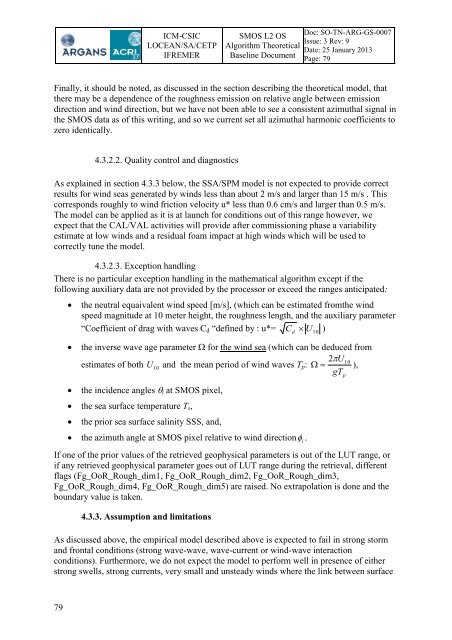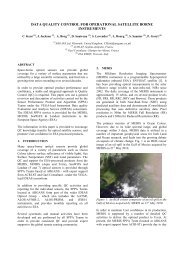SMOS L2 OS ATBD - ARGANS
SMOS L2 OS ATBD - ARGANS
SMOS L2 OS ATBD - ARGANS
You also want an ePaper? Increase the reach of your titles
YUMPU automatically turns print PDFs into web optimized ePapers that Google loves.
79<br />
ICM-CSIC<br />
LOCEAN/SA/CETP<br />
IFREMER<br />
<strong>SM<strong>OS</strong></strong> <strong>L2</strong> <strong>OS</strong><br />
Algorithm Theoretical<br />
Baseline Document<br />
Doc: SO-TN-ARG-GS-0007<br />
Issue: 3 Rev: 9<br />
Date: 25 January 2013<br />
Page: 79<br />
Finally, it should be noted, as discussed in the section describing the theoretical model, that<br />
there may be a dependence of the roughness emission on relative angle between emission<br />
direction and wind direction, but we have not been able to see a consistent azimuthal signal in<br />
the <strong>SM<strong>OS</strong></strong> data as of this writing, and so we current set all azimuthal harmonic coefficients to<br />
zero identically.<br />
4.3.2.2. Quality control and diagnostics<br />
As explained in section 4.3.3 below, the SSA/SPM model is not expected to provide correct<br />
results for wind seas generated by winds less than about 2 m/s and larger than 15 m/s . This<br />
corresponds roughly to wind friction velocity u* less than 0.6 cm/s and larger than 0.5 m/s.<br />
The model can be applied as it is at launch for conditions out of this range however, we<br />
expect that the CAL/VAL activities will provide after commissioning phase a variability<br />
estimate at low winds and a residual foam impact at high winds which will be used to<br />
correctly tune the model.<br />
4.3.2.3. Exception handling<br />
There is no particular exception handling in the mathematical algorithm except if the<br />
following auxiliary data are not provided by the processor or exceed the ranges anticipated:<br />
the neutral equaivalent wind speed [m/s], (which can be estimated fromthe wind<br />
speed magnitude at 10 meter height, the roughness length, and the auxiliary parameter<br />
“Coefficient of drag with waves Cd “defined by : u*= Cd U10<br />
)<br />
the inverse wave age parameter for the wind sea (which can be deduced from<br />
2U<br />
10<br />
estimates of both U 10 and the mean period of wind waves Tp: ),<br />
gT<br />
the incidence angles i at <strong>SM<strong>OS</strong></strong> pixel,<br />
the sea surface temperature Ts,<br />
the prior sea surface salinity SSS, and,<br />
the azimuth angle at <strong>SM<strong>OS</strong></strong> pixel relative to wind direction i .<br />
If one of the prior values of the retrieved geophysical parameters is out of the LUT range, or<br />
if any retrieved geophysical parameter goes out of LUT range during the retrieval, different<br />
flags (Fg_OoR_Rough_dim1, Fg_OoR_Rough_dim2, Fg_OoR_Rough_dim3,<br />
Fg_OoR_Rough_dim4, Fg_OoR_Rough_dim5) are raised. No extrapolation is done and the<br />
boundary value is taken.<br />
4.3.3. Assumption and limitations<br />
As discussed above, the empirical model described above is expected to fail in strong storm<br />
and frontal conditions (strong wave-wave, wave-current or wind-wave interaction<br />
conditions). Furthermore, we do not expect the model to perform well in presence of either<br />
strong swells, strong currents, very small and unsteady winds where the link between surface<br />
p



